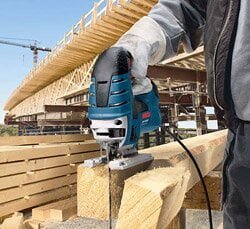The jigsaw is a truly multi-purpose and at the same time functional tool that is indispensable both for beginners and professional jigsaws. This tool, in addition to the direct purpose of the jigsaw, which performs sawing of surfaces on any given curves, performs operations straight and oblique cuts, thereby replacing the manual or desktop circular saw.
When working with electric jigsaws there are general principles of use
- Do not skimp on the purchase of quality saw blades – those that come with, as a rule, are the most
 coarse and cheap, are suitable for irresponsible work. Immediately check the correspondence of the blade shank to the clamping chuck on your jigsaw, there are several varieties of them.
coarse and cheap, are suitable for irresponsible work. Immediately check the correspondence of the blade shank to the clamping chuck on your jigsaw, there are several varieties of them. - The less susceptible to vibration is the cutting surface, the more accurate and comfortable it is to work. That is why you should try to reliably secure the workpiece from movement with wedge clamps or several clamps.
- In addition to the requirement for a good saw blade, professional training of the jigsaw user is just as important for a good cut. It is necessary to strictly dose the force of pressure on the tool when moving it along the saw line, excessive pressure causes overloading of the jigsaw mechanisms, taking the saw blade sideways. Ideally the jigsaw should move freely and if there is a feeling of difficulty in sawing, it indicates the loss of sharpness of the cutting edges of the saw teeth.
- When particularly demanding and precise finish cuts are required, for example when fitting exterior elements of wooden furniture, special saw blades designed for such work must be used. It is also necessary to choose the zero position of the pendulum stroke, which structurally ensures a better cleanness of the saw. However, in the case of cutting thick solid wood along the fibers, a better cut is obtained by selecting the reciprocating stroke of the pendulum in position “1”.
- Adjustable pendulum stroke allows to choose the most optimal step of the saw blade movement to achieve the maximum cutting speed along the fibers. Additionally this function tilts the blade by a certain angle thus reducing the lateral movement of the saw blade away from the line of cut.
- Do not neglect protective equipment – when working with a jigsaw, sawdust flying out of the working area is especially dangerous. Unfortunately, not all jigsaws have the included vacuum cleaner connector that connects freely to its corrugated hose. Therefore, if you wear safety glasses while working, you will protect yourself from possible injuries, and you will be able to observe the cutting area more confidently.
- It is better to saw not along the pre-marked line, but close to it – leaving it on the sawn-off workpiece. This way the highest precision cuts are achieved.
- Thin materials are best sawed face down, so there are fewer splinters. It makes sense to saw thicker materials with the face upwards, because of the probability that the saw may drift sideways away from the perpendicular in the lower plane.
- In some situations, the use of an electric jigsaw for sawing long thin workpieces is not justified by the results achieved. If you do not have a circular or band fixed saw, it is advisable to make such a cut with a hand hacksaw followed by finishing shavings with a planer.